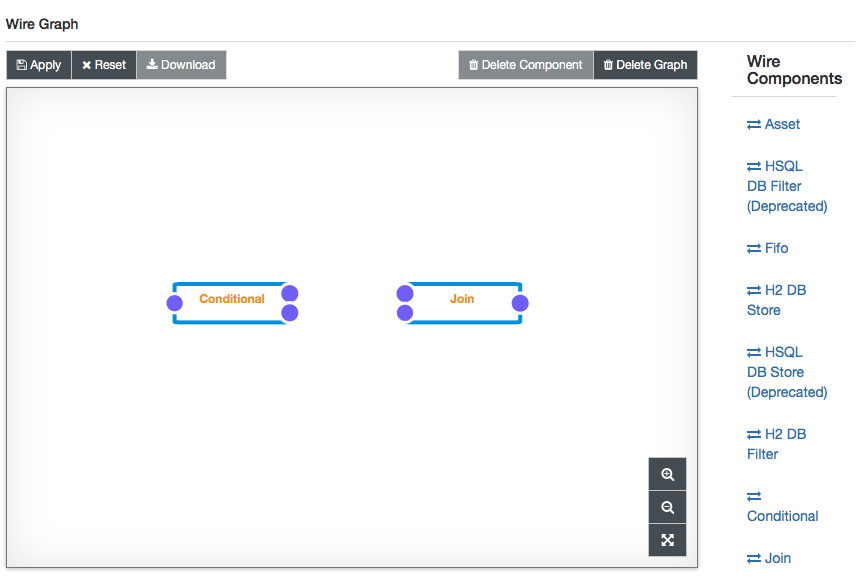Multiport Wire Components
In order to allow a better routing of data through the Wire Graph, ESF introduces a new class of Wire components named Multiport Wire Components.
With the addition of this new functionality, a compatible component instance can be defined with an arbitrary number of input and output ports.

In the example provided, we have two components in the Wire Composer:
- the Conditional component that implements the if-then-else logic
- the Join component that joins into a single Wire the data processed by two separate branches of a graph
Those components are available in every default installation of ESF.
In order to show the potentialities of the new APIs, in the Eclipse Kura Marketplace and in the ESF downloads page, are available few more multiport-enabled components for Mathematical processing.
Convert a Component to a Multiport Component
Component Configuration Changes
The following properties need to be specified in the component configuration:
- input.cardinality.minimum: an integer that specifies the minimum number of input ports that the component can be configured to manage.
- input.cardinality.maximum: an integer that specifies the maximum number of input ports that the component can be configured to manage.
- input.cardinality.default: an integer that specifies the default number of input ports that the component will be created with, if not specified in a different way.
- output.cardinality.minimum: an integer that specifies the minimum number of output ports that the component can be configured to manage.
- output.cardinality.maximum: an integer that specifies the maximum number of output ports that the component can be configured to manage.
- output.cardinality.default: an integer that specifies the default number of output ports that the component will be created with, if not specified in a different way.
- input.port.names: optional mapping between input ports and friendly names
- output.port.names: optional mapping between output ports and friendly names
The component should also provide service interface org.eclipse.kura.wire.WireComponent
Code Changes
To leverage all the new Multiport functionalities, a Multiport-enabled component must use the newly introduced MultiportWireSupport APIs that provide support to get the list of Emitter and Receiver Ports, as well as to create a new Wire Envelope from a list of Wire Records.
For the conditional component, that has two output ports, the following code allows to get the proper Wire Support from the Wire Helper Service and to get the then and else ports to be used to push the processed envelopes.
this.wireSupport = (MultiportWireSupport) this.wireHelperService.newWireSupport(this);
final List<EmitterPort> emitterPorts = this.wireSupport.getEmitterPorts();
this.thenPort = emitterPorts.get(0);
this.elsePort = emitterPorts.get(1);To emit the result, the code has to be adapted to use the Wire Support to create the Wire Envelope that has to be sent. Effectively, the envelope is sent to the corresponding wire invoking the emit method of the corresponding Port, as shown below:
final WireEnvelope outputEnvelope = this.wireSupport.createWireEnvelope(inputRecords);
if ((Boolean) decision) {
this.thenPort.emit(outputEnvelope);
} else {
this.elsePort.emit(outputEnvelope);
}Updated about 2 months ago
